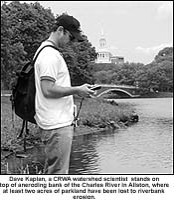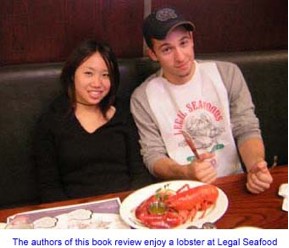During the past decade new types of wild creatures have appeared in parks, woodlands and backyards of the city. In addition to the usual skunks, raccoons, squirrels, rabbits, chipmunks, and Canada geese, there are now coyotes, foxes, bobcats, fisher, weasels, river otter, wild turkeys, and an increasingly large white-tailed deer population. Moose have not yet appeared in Newton, but they have had front-page notice in towns nearby, and black bears have reentered the forests of western Massachusetts. Will they be our next big visitors?
Reasons for this change were presented by Colleen Olfenbuttel, staff member of the Massachusetts Division of Fisheries and Wildlife www.masswildlife.org, in her Nov. 15 lecture at the Newton Free Library sponsored by the Newton Conservators. She noted that all of these animals were living in the forests of New England when European settlers arrived in the 17th century. They disappeared after the trees were cut for timber and the land cleared for farming. By 1840, much of the soil was exhausted, farming became more difficult, and people moved to richer lands of the Midwest or sought their fortunes in large cities with the coming of the industrial revolution.
 Since that time, our forests have returned, and now an estimated 70% of Massachusetts is covered with second growth. This has led to restoration of wild animal populations, with the exception of wolves and mountain lions, entirely extirpated from the Northeast through bounty hunting. As housing has exploded into rural areas, with developments rising in forested landscapes, human encounters with wildlife have increased. Suburban gardens, shrubs, fruit trees, and bird feeders provide tempting food for many wild creatures, and garbage added to mulch piles or left outside in trash bags spells "dinner" for raccoons, skunks and coyotes. Crawl spaces under porches and garages attract these same animals, also foxes, as dens for rearing young. With hunting prohibited, large predators absent, food supplies handy, and living space provided, why should they forego such comforts?
Since that time, our forests have returned, and now an estimated 70% of Massachusetts is covered with second growth. This has led to restoration of wild animal populations, with the exception of wolves and mountain lions, entirely extirpated from the Northeast through bounty hunting. As housing has exploded into rural areas, with developments rising in forested landscapes, human encounters with wildlife have increased. Suburban gardens, shrubs, fruit trees, and bird feeders provide tempting food for many wild creatures, and garbage added to mulch piles or left outside in trash bags spells "dinner" for raccoons, skunks and coyotes. Crawl spaces under porches and garages attract these same animals, also foxes, as dens for rearing young. With hunting prohibited, large predators absent, food supplies handy, and living space provided, why should they forego such comforts?Living with wildlife in our surroundings is a source of pleasure for most Newton residents, but we find some challenges in our attempt to maintain a healthy and happy coexistence with these new species as they return to their rightful domain. In order that they may be protected and continue normal patterns of behavior in the wild, it is important that they not become dependent on humans for food and living space. To underscore this point, Olfenbuttel introduced a discussion of the coyote, displaying a beautiful mounted specimen of the animal. Many who had never seen one in the wild expressed surprise at its relatively small size - its average weight is only 40 pounds.
She described the territorial behavior of the coyote. Its howling and yipping at night are a means of keeping in touch with other members of its group - and a warning to outsiders to stay away! Coyotes are shy and wary by nature, avoiding contact with people. Their diet is varied, and they can be tempted into neighborhoods where food is available. True omnivores, they prey on small mammals such as squirrels and chipmunks, but they also like fruits, berries, and birdseed. They will eat road kill or any pet food or garbage left outdoors. They have been known to run down unprotected small house pets. Owners of cats and little dogs are advised to keep them indoors. (Because house cats, across the nation, kill millions of birds each year, there is further reason to keep them inside!)
To maintain coyotes in their normal wild state, Mass Wildlife suggests the following:
1. Don’t feed or try to pet them!
2. Put garbage outdoors in strong containers, not plastic bags
3. Feed pets indoors so unfinished food is not left outside.
4. Don’t let cats or small dogs roam freely outside
5. Keep areas under bird feeders clean
6. Close off crawl spaces under porches.
If coyotes become persistent in hanging around, help them to remain wary of humans by scaring them off with loud noises, a bright light, or even water sprayed from a hose if necessary.
Wild turkeys and the Canada Goose are also year-round Newton residents, but these animals will be discussed in another article.
The goal of conservation is to preserve appropriate habitat for those species rejuvenated by the return of our forests, allowing them to live in nature as they were originally born to it. The effort of Mass Wildlife is to reacquaint the public with the particular needs and behaviors of these animals, so they can remain as wild creatures while sharing much of their territory with the human population.
Environmental Show on NewTV. This episode of The Environmental Show travels along with teens as they go hiking, biking, canoeing and climbing, and visit woods and ponds, the Charles River, parks, a salt marsh, and mountains, winding up with a stay at the highest peak in the northeast (Mt. Washington). They also participate in a hands-on environmental cleanup project each year. As several of the teens point out, they make friends and have fun while they’re out there.
This episode of The Environmental Show travels along with teens as they go hiking, biking, canoeing and climbing, and visit woods and ponds, the Charles River, parks, a salt marsh, and mountains, winding up with a stay at the highest peak in the northeast (Mt. Washington). They also participate in a hands-on environmental cleanup project each year. As several of the teens point out, they make friends and have fun while they’re out there. Tragically, nearly a quarter of all bat species are threatened by extinction, mainly due to habitat loss, hunting, disturbance at roost sites and pesticides. Conservation has been greatly impeded by a lack of understanding of these animals. Demonized and feared across cultures for centuries, shrouded in myth and prejudice, bats now face another challenge to their unfairly tarnished image - their role as natural wildlife reservoirs in the emergence of new and sometimes fatal infectious diseases.
Tragically, nearly a quarter of all bat species are threatened by extinction, mainly due to habitat loss, hunting, disturbance at roost sites and pesticides. Conservation has been greatly impeded by a lack of understanding of these animals. Demonized and feared across cultures for centuries, shrouded in myth and prejudice, bats now face another challenge to their unfairly tarnished image - their role as natural wildlife reservoirs in the emergence of new and sometimes fatal infectious diseases. What caused this change in feeding behavior to become so drastic and satisfying to them and troublesome to gardeners? The droughty years that began in 1993 and lasted more or less until 2004. Acorns are the fruits (and seeds) of oak trees and the main staple of squirrels while still on the tree. The calories stored in acorns is in the form of fat and other organic compounds that help squirrels, and other animals, get through the winter months. Squirrels prefer to feed immediately on the acorns of White Oak (Quercus alba) and will bury the high tannin content acorns of Red Oak (Q. rubra) and Black Oak (Q. velutina) for eating at a later date. Acorns are buried at shallow depths for better olfactory detection. Experiments have proven that squirrels find their buried acorns by smelling them and not by memory.
What caused this change in feeding behavior to become so drastic and satisfying to them and troublesome to gardeners? The droughty years that began in 1993 and lasted more or less until 2004. Acorns are the fruits (and seeds) of oak trees and the main staple of squirrels while still on the tree. The calories stored in acorns is in the form of fat and other organic compounds that help squirrels, and other animals, get through the winter months. Squirrels prefer to feed immediately on the acorns of White Oak (Quercus alba) and will bury the high tannin content acorns of Red Oak (Q. rubra) and Black Oak (Q. velutina) for eating at a later date. Acorns are buried at shallow depths for better olfactory detection. Experiments have proven that squirrels find their buried acorns by smelling them and not by memory. "CRWA, known for its work in protecting, preserving and enhancing the Charles River and its watershed, is creating a new approach to urban redevelopment," said Bob Zimmerman, executive director of Charles River Watershed Association. "We want to build 'blue cities' - cities that are designed to sustain and restore water resources."
"CRWA, known for its work in protecting, preserving and enhancing the Charles River and its watershed, is creating a new approach to urban redevelopment," said Bob Zimmerman, executive director of Charles River Watershed Association. "We want to build 'blue cities' - cities that are designed to sustain and restore water resources." Trevor Corson's "The Secret Life of Lobsters" offers an intellectual awakening on an anecdotal plate. He interweaves stories of lobstermen and scientists, offering a hint of the friction between the two groups, while demonstrating their common love of lobsters. Having spent his childhood summers on Little Cranberry Island, Corson developed an early interest in lobstering and he gained a general appreciation of the village's economic dependence on the lobster industry. Later in his life, he spent two years working full-time aboard a lobster boat and gained a much deeper appreciation of lobstering: "I wanted to be a marine biologist when I grew up, but also a commercial fisherman."
Trevor Corson's "The Secret Life of Lobsters" offers an intellectual awakening on an anecdotal plate. He interweaves stories of lobstermen and scientists, offering a hint of the friction between the two groups, while demonstrating their common love of lobsters. Having spent his childhood summers on Little Cranberry Island, Corson developed an early interest in lobstering and he gained a general appreciation of the village's economic dependence on the lobster industry. Later in his life, he spent two years working full-time aboard a lobster boat and gained a much deeper appreciation of lobstering: "I wanted to be a marine biologist when I grew up, but also a commercial fisherman." 